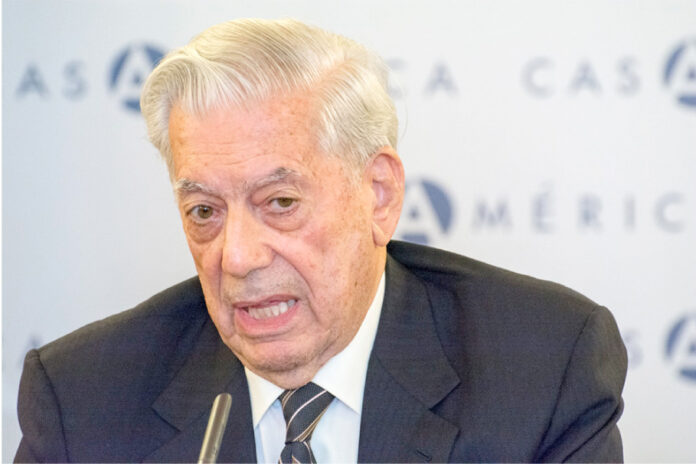The Nobel Prize-winning Peruvian author leaves behind a legacy of unforgettable works that shaped the history of Latin American thought and narrative.
by the El Reportero team
Mario Vargas Llosa, one of the greatest Spanish-language writers, died on April 13, 2025, at the age of 89 in Lima, Peru.
His death closes a golden era of Latin American literature. Author of iconic novels such as The City and the Dogs, Conversation in the Cathedral, and The Feast of the Goat, Vargas Llosa received the Nobel Prize in Literature in 2010, crowning a brilliant career.
With his death, a brilliant chapter in world literature closes. Author of iconic novels such as The City and the Dogs, Conversation in the Cathedral, The Green House, and The Feast of the Goat, Vargas Llosa captured, with a sharp and committed pen, the political, moral, and social conflicts of Latin America. In 2010, he was awarded the Nobel Prize in Literature, crowning a career marked by literary excellence and ideological controversy.
From Arequipa to the world
Jorge Mario Pedro Vargas Llosa was born in Arequipa, Peru, on March 28, 1936. His childhood was marked by the separation of his parents and a restless youth that took him to Cochabamba (Bolivia), Lima, and Piura. He studied Literature and Law at the National University of San Marcos, and later completed a doctorate at the Complutense University of Madrid.
He felt a calling to write very early. He published his first book, The Bosses, in 1959, which earned him the Leopoldo Alas Prize. But it was with The City and the Dogs (1963) that he burst onto the international scene. This novel, set in a Lima military school, scandalized conservative sectors of Peru but opened the door to global recognition.
A committed and fierce work
Vargas Llosa’s fiction is marked by a complex structure, a critical view of power, and a profound exploration of the human soul. Works such as The Green House (1966) and Conversation in the Cathedral (1969) consolidated his reputation as a masterful storyteller. These novels display an experimental style, influenced by William Faulkner and European tradition, but with an authentically Latin American voice.
In the 1980s and 1990s, his literary output became more diverse in tone and subject matter. Highlights include The War at the End of the World (1981), inspired by an episode in nineteenth-century Brazil, and The Feast of the Goat (2000), about Rafael Leónidas Trujillo’s dictatorship in the Dominican Republic, one of his most widely read and acclaimed novels.
Throughout his career, he also dabbled in essays, journalism, and cultural criticism. He was a passionate defender of liberal democracy and a critic of authoritarianism, which led him to break with his former leftist colleagues. This ideological shift was also expressed in his political life, when he unsuccessfully ran for the presidency of Peru in 1990 against Alberto Fujimori.
A long-awaited Nobel Prize
When he received the Nobel Prize for Literature in 2010, the Swedish Academy praised his “cartography of power structures and steely images of resistance, rebellion, and the defeat of the individual.” Vargas Llosa celebrated with a moving speech entitled “In Praise of Reading and Fiction,” in which he reaffirmed his faith in the power of words to understand and change the world.
The Nobel Prize recognized not only his narrative work, but also his commitment to freedom of thought, the Spanish language, and the role of literature as a critical conscience of society.
Between literature and controversy
Despite his unquestionable literary talent, Vargas Llosa was a figure who did not shy away from conflict. His political stances and criticisms of leftist regimes like those of Cuba and Venezuela earned him enemies, while his closeness to liberal sectors and his defense of the market generated intense debate. Even in his later years, he maintained an active presence in the media, opining on international politics, feminism, and the future of Latin America.
On a personal level, his life was also exposed to the public eye. His romantic relationship with Isabel Preysler, his separation from Patricia Llosa—with whom he had three children—and his presence in the tabloid press contrasted with the figure of the classic intellectual. However, he always returned to writing as a refuge and reason for existence.
An immortal legacy
Mario Vargas Llosa leaves behind a legacy of more than 20 novels, dozens of essays, plays, chronicles, and newspaper columns. His influence is unquestionable among generations of writers and readers, not only for his technical mastery but for his defense of free thought and the plurality of ideas.
Today, the world bids farewell to a writer who not only narrated Latin American history with rawness and beauty, but also helped shape it. His voice will live on in his books, in libraries, and in the consciences of those who understand that literature is also a form of resistance.
He is survived by his three children: Álvaro Vargas Llosa, Gonzalo Vargas Llosa, and Morgana Vargas Llosa. He is also survived by his ex-wife, Patricia Llosa Urquidi.
Mario Vargas Llosa will not be buried, as his last wish was that his remains be cremated. The cremation took place at the Chorrillos Army Funeral and Crematorium Center in Lima.
Rest in peace, Maestro Vargas Llosa.



